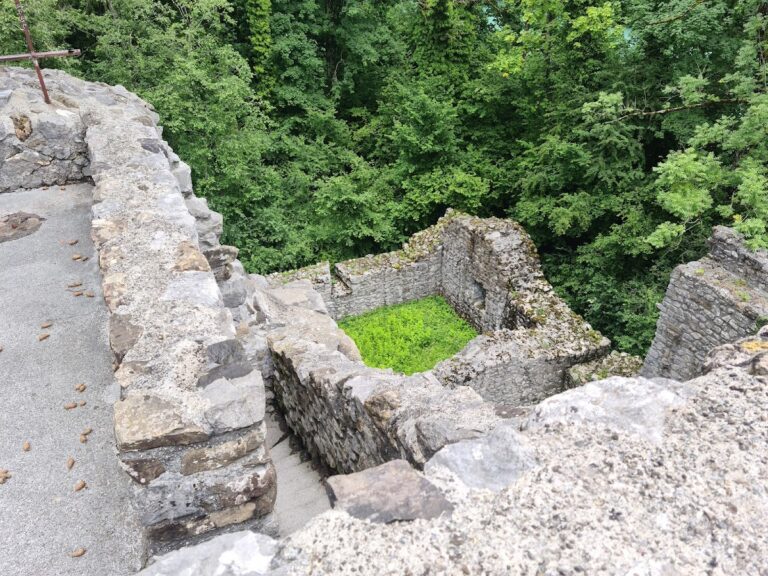Unspunnen Castle: A Medieval Fortress in Switzerland
Visitor Information
Google Rating: 4.3
Popularity: Very Low
Google Maps: View on Google Maps
Official Website: www.interlaken.ch
Country: Switzerland
Civilization: Unclassified
Remains: Military
History
Unspunnen Castle is situated in the municipality of Wilderswil in Switzerland. It was likely built during the early 1100s by a baronial family whose exact identity remains unknown. The castle served as the center of a fiefdom in the Bernese Oberland region throughout the 13th and 14th centuries.
By the early 13th century, Unspunnen Castle had become an important seat of power, first mentioned in records dating to 1232. Alongside the cave castle of Rotenfluh, noted in 1298, it guarded the strategic Lütschinenbrücke bridge near Interlaken, controlling access routes through the northern Alps. The castle’s ownership shifted in 1224 when Burkart of Thun gained control through marriage ties with the Baron of Wädenswil’s family. Around 1280, the estate fragmented: Unspunnen and associated villages came under the Baron of Eschenbach, while the Baron of Weissenburg took possession of Rotenfluh and other lands.
Following the 1308 assassination of King Albert I, the Austrian Habsburg dynasty claimed the Eschenbach estates. This claim led to Unspunnen Castle’s pledge to the Baron of Weissenburg in 1318 as security for the Habsburgs. Social tensions erupted in 1332 when local peasants revolted against Johann of Weissenburg; the uprising was crushed, and the captives were imprisoned within the castle walls.
In 1334, the city of Bern launched a military expedition into the Oberhasli region, besieging and capturing Unspunnen Castle. Prisoners were then freed, though the barons maintained nominal ownership. The castle’s fate was influenced by wider conflicts: after Bern’s victory at the Battle of Laupen in 1339, Unspunnen was pledged to Bern as part of peace negotiations. Ownership again shifted in 1342 when the Habsburgs reclaimed the pledge and granted it to their allies, including the lords of Interlaken, Hallwyl, and Kyburg.
During the Battle of Sempach in 1386, Bern expanded its influence in the region, eventually redeeming the castle’s mortgage in 1397. The subsequent year saw the castle and lands sold to prominent Bernese families, von Seftigen and von Scharnachtal. Bern reacquired these estates from heirs in 1418 and again in 1515, placing Unspunnen under direct city governance by 1529.
By the mid-18th century, administration of Unspunnen’s lands transferred to the town of Interlaken. Thereafter, the castle ceased to be maintained, leading to its gradual decline into ruin. Despite its ruinous state, Unspunnen Castle gained cultural recognition through the Unspunnenfest, a traditional Swiss festival first held in 1805 on the fields beneath the castle, ensuring occasional upkeep of the site.
Remains
The ruins of Unspunnen Castle occupy a strategic location overlooking the town of Interlaken and the vital Lütschinenbrücke bridge. Although originally constructed in the early 12th century, the remains today consist only of fragments of the once-standing structure, providing a limited sense of the castle’s original layout or architectural style.
The surviving ruins indicate a fortified site designed for defense and control, consistent with its historical role in guarding important regional routes alongside the nearby Rotenfluh cave castle. The exact materials and building techniques are not documented, but the castle’s placement suggests a typical medieval hilltop fortress built to oversee and protect the surrounding valleys.
Today, the site is recognized for its connection with the longstanding cultural tradition of the Unspunnenfest, which takes place on the adjacent fields. Periodic clearing and minor restoration efforts have been undertaken since the festival’s inception in the early 19th century, helping to preserve what remains of the castle. No specific structural elements such as gates, stairways, or inscriptions have been recorded in the archaeological surveys, leaving the ruins as a subtle reminder of the castle’s historical presence rather than a fully interpretable monument.










